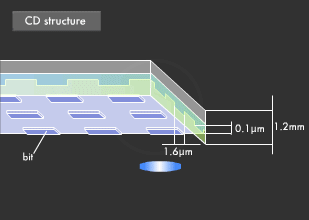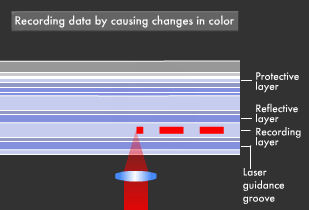Canon Science Lab
CDs and DVDs
Compact discs(CDs) are perhaps the most commonly used form of digital recording media in our lives today, and optical technologies are used to both read and write data on them.
CDs are the most widespread form of optical recording media in use today. Originally developed as a means of recording audio data, CD technology has evolved into CD-ROMs, which record and store digital images and many other kinds of digital data. The inner face of CDs is scored with pits several micrometers long, which are arranged in a continuous spiral, and represent recorded data. Laser light is focused on these pits, and data is read by picking up the reflected light. DVDs work according on essentially the same principle.
Data Is Recorded as Pits on the Inner Face of Discs
CDs are made up of three layers: a clear plastic layer about 1.2 mm thick, on top of which a thin, reflective aluminum layer is laid, followed by a thin, protective acrylic layer. Data is recorded on the inner face of the clear plastic layer facing the reflective aluminum layer, in the form of pits that are 0.5 μm ( 1 μm = one millionth of a meter ) in width, and several micrometers in length. When CD data is read, laser light is focused through the clear plastic layer, and data gathered by reading the differences in reflected light intensities from the aluminum layer caused by the pits.

Optical Pickups Use Lenses to Collect Reflected Laser Beams
The device used to read the CD data is known as an optical pickup. The laser beam generated by a laser diode is passed through collimating lenses to render it as parallel rays, and then focused by an objective lens to a tiny spot that strikes the reflective layer. The beam reflected from the aluminum reflective layer is then divided by a polarizing beam-splitting prism and passed through a cylindrical lens to a photodetector array, where it is read as data.

CD-Rs Record Data Through Color Change
Instead of pits, CD-Rs (Compact Disc-Recordable) have a layer of bluish photosensitive organic dye, which is backed by a very thin reflective layer usually made of gold. When struck by a strong laser beam, the photosensitive dye absorbs light, heating the reflective layer in a localized pattern, and causing deformations in the reflective layer. This is why the phrase "burning a CD-R" is used, since laser light is used to burn data into the dye and reflective layers. The variations in reflectivity caused by such burning of data onto a CD-R are equivalent to the pits of CDs.

CD-RWs Record Data with Phase-Change Materials
CD-RWs (Compact Disc-ReWritable) enable the repeated writing of data onto a disc by using special alloys possessing what are known as "phase-change" properties. After being heated to a liquid form, certain alloys retain an amorphous condition on sudden cooling, instead of recrystallizing. When heated by the writing laser beam of a CD-RW writer, the alloy is transformed from a crystalline state to this amorphous condition.

When the writing laser beam burns data on a CD-RW, it accordingly creates a stream of amorphous, low-reflective spots (recorded state) interrupted by crystalline, high-reflective spots (erased state), these two states representing the 0s and 1s of digital data, which can then be read by a reading laser beam. Data is erased on CD-RWs by using an erasing laser beam, which is too weak to melt the material, but heats it to crystallization point, and then allows the material to cool slowly, restoring the alloy to its crystalline state, and effectively erasing the 0s. The use of phase-change alloys enables a CD-RW to be rewritten over 1,000 times.
Doubling Data Storage Capacity with Blue Lasers
As explained previously, data is recorded on CDs through the use of little spots of different reflectivity. This means that the smaller the size of the spots used, the more data can be incorporated onto a single disc. It is for such reasons that blue-laser data storage is drawing a lot of attention these days. The red lasers used until now create spots of about 1 μm in diameter, whereas blue lasers can create spots half this size, about 500 nanometers in diameter. This means that, calculated simply, four times as much data can be stored on a disc of the same size as a CD or DVD.

